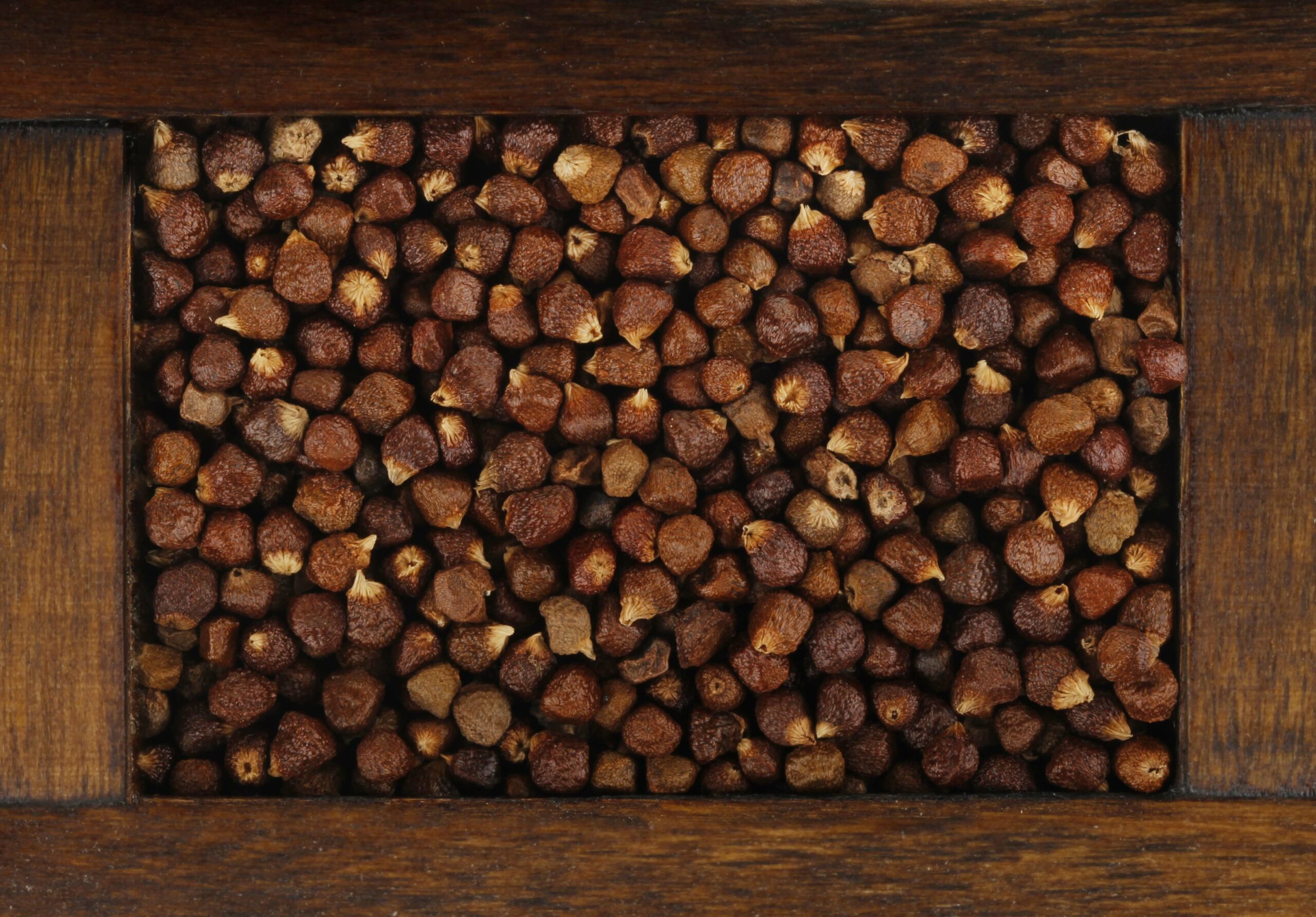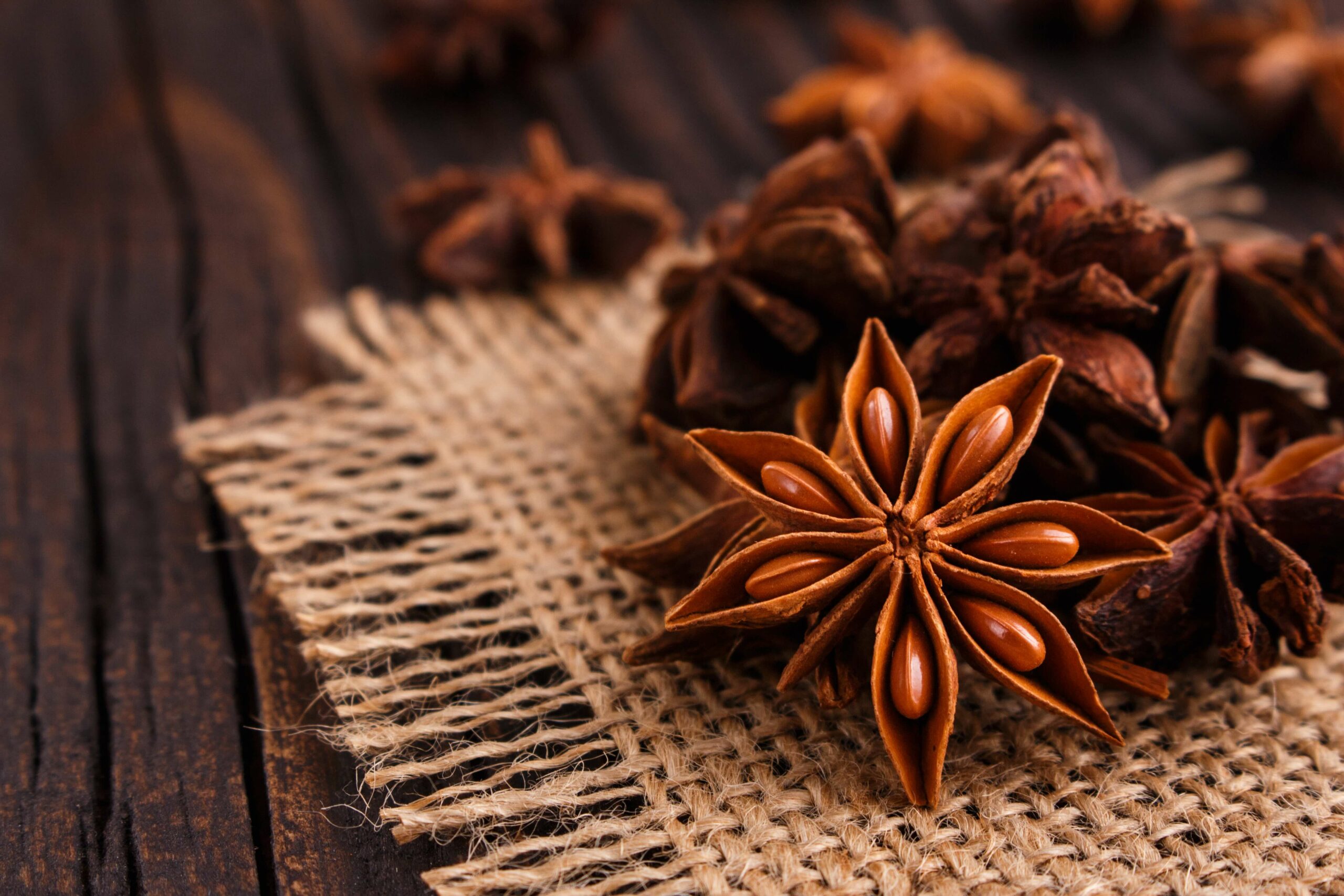Essential spices in Ghanaian cuisine

Ghanaian cuisine is a wonderful blend of flavours, textures and spices. Read on to discover the essential spices that turn the country’s most popular dishes, like Jollof Rice and Waakye, into delicious, flavourful meals.
Ghana is located along the “Gold Coast” of West Africa. And it has an extremely diverse cultural landscape, with serene savannas, lush rainforests, beautiful beaches and spectacular mountains. But the country has an incredibly rich culinary landscape too – a reflection of Ghana’s diverse population, with more than 70 native ethnic groups.
An introduction to Ghanaian cuisine
Ghanaian cuisine is vibrant and flavourful, so it’s no wonder that spices play a major role in cooking. Jollof Rice is an iconic one-pot dish known for its bold, spicy flavours. It’s traditionally cooked in a rich tomato-based sauce with jasmine or basmati rice, and a blend of spices to enhance its flavour, including ginger, thyme, ground pepper and garlic.
Waakye is another quintessential Ghanaian one-pot recipe. A unique and delicious take on rice and beans, Waakye is often eaten for breakfast and lunch in Ghana, and features a range of spices to add smokiness, warmth and a hint of sweetness, such as smoked paprika, thyme and ginger.
So now you’ve had a little taste of Ghanaian cuisine, we’ll explore the essential spices that form the basis of many of the country’s most loved dishes – many of which you may never have even heard of…
Calabash Nutmeg
Calabash nutmeg, also known as Hwediaba, has a stronger taste than traditional nutmeg. This shelled spice features heavily in many Ghanaian dishes, and comes from the evergreen forests of West Africa. Calabash Nutmeg has a warm, nutty taste with woody undertones, which make it ideal for seasoning savoury dishes like soups and stews. It’s also used to add nuttiness to salads and sweet dishes.

How to cook with Calabash Nutmeg
To cook with Calabash Nutmeg, you need to roast it for a good five minutes, before using a pestle to crack open the shell – you may need longer if it’s being stubborn. You can then use the flesh to add spice and fragrance to your recipe. Roasting also intensifies its flavour.
What Ghanaian dishes use Calabash Nutmeg?
Fufu, a starchy, staple dish similar to the consistency of mashed potato, often served with soup or stew, Egusi soup, Okro soup, Red Red stew and Jollof Rice, all include Calabash Nutmeg.
Does Calabash Nutmeg have any health benefits?
Not only does Calabash Nutmeg feature heavily in Ghanaian cooking, it’s also used by certain communities for its medicinal properties, including lowering cholesterol, preventing nausea, repelling insects, curing headaches and treating eye diseases.
Grains of Paradise
Grains of Paradise, known as Efom Wisa in Ghana, is a member of the ginger family. It goes by many other names too, including Alligator Pepper, Melegueta Pepper, Guinea Pepper and Guinea Grains. It’s a West African aromatic spice that looks like pink peppercorns, and is grown in Ghana, Guinea, Nigeria and Sierra Leone. The seeds come from the plant aframomum melegueta, and they’re widely used in Ghanaian stews and soups. They can also be used in sweet dishes as an alternative to cardamom, citrus peel, cloves, or ginger.

Grains of Paradise is one of the most expensive Ghanaian natural spices, and has a complex, unique flavour profile with its woody aroma, and sharp, peppery, citrusy, herby taste. If you bite into a seed, the heat slowly intensifies.
How to cook with Grains of Paradise
Grains of Paradise is used as a substitute for ground black pepper to add heat and flavour. You can crush the spice in a spice grinder or with a mortar and pestle. Once crushed, the seeds release an abundance of flavour. At first they smell quite pungent and peppery, then you’ll get hit with a floral aroma, with hints of jasmine, cardamom and clove.
What Ghanaian dishes use Grains of Paradise?
Jollof Rice, Kelewele (a popular Ghanaian plantain street food), and Sobolo, a favourite, refreshing Ghanaian drink, all use Grains of Paradise to add heat.
Does Grains of Paradise have any health benefits?
Grains of Paradise is used by many Ghanaian communities as a remedy for snake bites, diarrhoea and other stomach disorders. The seeds are also crushed and brewed as a treatment for wounds.
Grains of Selim
Grains of Selim, or Hwentia, is a popular pod-based Ghanaian spice, and like Calabash Nutmeg, when crushed, it’s a perfect substitute (or addition) to black pepper. The spice has a smoky, musky, woody, flavour – reminiscent of summer barbeques. But it’s equally quite floral, giving Grains of Selim a somewhat unique, robust flavour profile.

How to cook with Grains of Selim
When it comes to cooking with Grains of Selim, a little goes a long way. The pods contain around five to eight seeds, but Ghanaians recommend using it whole – if you crush too many and expose the seeds, it can make your dish taste quite bitter. If you add the pods to porridge, sauce, soups or stews, it’s recommended you remove them after cooking. To make removing the pods easier, you can tie them with kitchen string or twine.
What Ghanaian dishes use Grains of Selim?
Grains of Selim is an essential Ghanaian spice for making Shito (or Shitor), a hot pepper sauce that’s a staple in many Ghanaian homes. Every household’s recipe is slightly different, but this popular condiment pairs perfectly with fish and meat, and can be enjoyed with a number of rice dishes like Jollof Rice and Waakye. Grains of Selim is also a great addition to porridge, stews, soups, Kelewele, and Sobolo. The pods are also smoked, crushed and used as a rub for meat or fish.
Does Grains of Selim have any health benefits?
Apart from its culinary benefits, many Ghanians use Grains of Selim to relieve sore throats by chewing on the pods. It’s also used to help treat asthma, rheumatism and other inflammatory health conditions.
DawaDawa or Iru
DawaDawa, or Iru, is a pungent, aromatic spice made from the fermented seeds of the African locust bean tree. The lumpy, round spheres have a slightly sticky texture and pungent, umami flavour, and are mainly used in northern Ghana to enhance the flavour of a number of dishes, including rice, soups and stews. DawaDawa is as important to Ghanaian cooking as onions and peppers, and takes pride of place in every household’s spice rack.

How to cook with DawaDawa
DawaDawa should be used sparingly in cooking due to its pungent flavour. The fermented seeds are mainly used to make a condiment, and are sprinkled into soups, stews and sauces.
What Ghanaian dishes use DawaDawa?
DawaDawa is commonly used in Ghanaian groundnut soup, Egusi soup, palm nut soup, okra stew and Jollof Rice. The fermented seeds are also made into aromatic cakes. Basically, if you want to enhance the flavour of any recipe, add DawaDawa (but not too much).
Does DawaDawa have any health benefits?
DawaDawa comes from the African locust bean tree, and its seeds, leaves and bark are used by many West African communities to treat a variety of medical conditions. The bark is boiled and used to help heal wounds, relieve toothache and earache. While fermented locust bean seeds are used in controlling diabetes and cholesterol levels.
Cloves
Cloves are one of Ghana’s most widely used spices in cooking. Locally they’re known as Dadoa Amba or Pepre. Cloves are dry, unopened flower buds from the tropical myrtle tree family, and like many of Ghana’s spices, they’re used in both sweet and savoury dishes to add flavour – including porridge, sauces, tomato-based soups and stews. Cloves have a strong, warm, and somewhat spicy taste. That’s why they’re also a key ingredient for baking, and pair well with cinnamon and nutmeg.
How to cook with cloves
Cloves can be used whole or ground. Ghanaian cloves are very strong, so they should be used in moderation to avoid over seasoning.
What Ghanaian dishes use cloves?
Cloves are used in a variety of Ghanaian dishes. The fragrant spice is used to add flavour to Jollof Rice, Ghanaian groundnut soup and Kelewele. Cloves are also an essential ingredient in the drink Sobolo.
Do cloves have any health benefits?
Cloves have many health benefits and are known for their anti-inflammatory and antioxidant properties. They’re used to treat dental pain, aid digestion, help nausea and boost liver health.
Read our guide to cloves to find out more about this tiny spice with full-sized flavour.
Anise seeds
Anise seeds, known in Ghana as nketenkete ot nkitinkiti, are another essential spice in Ghanian cooking. They come from the anise plant, native to the eastern Mediterranean region and Southwest Asia, and are mighty in flavour. With a sweet, liquorice taste, anise seeds are used to enhance a variety of desserts, drinks, seafood, meat, stews and soups.

How to cook with anise seeds
Because of its potency, anise seeds should be used sparingly. They can be lightly toasted in a dry skillet to bring out their flavour – cooking them this way also makes them easier to grind. Anise seeds can also be simmered in soups, sauces and stews to add depth and complexity.
What Ghanaian dishes use anise seeds?
Anise seeds feature heavily in many local Ghanaian spice blends alongside ginger, Grains of Paradise, Grains of Selim and black pepper. They’re also used in Jollof Rice, Shito and Ghanaian groundnut soup.
Do anise seeds have any health benefits?
Anise seeds have a number of health benefits from improving digestion to alleviating cramps and nausea. Their antifungal, antibacterial and anti-inflammatory properties also help fight stomach ulcers and control blood sugar levels.
Some studies have shown that anise seeds can help in reducing the symptoms of depression and menopause.
How to store Ghanaian spices
To keep Ghanaian spices fresh and flavourful, store them in a cool, dry place, out of direct sunlight and away from heat. And keep them whole until you’re ready to cook with them.
Now you’ve learned all about essential Ghanaian spices, it’s time to use them to bring your dishes to life. And if you want to discover more flavourful spices and how to use them, check out our blog.